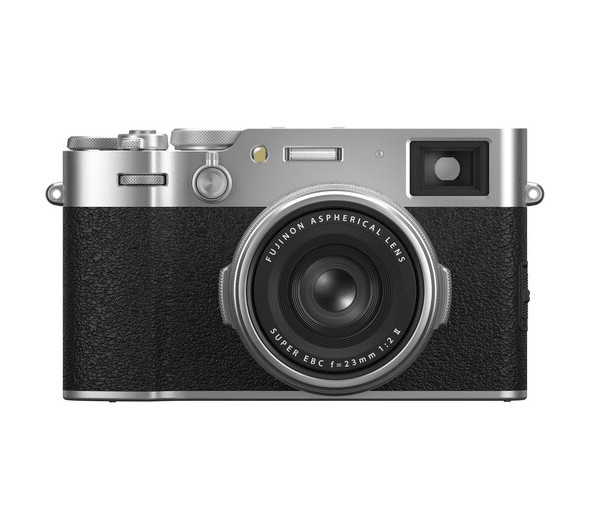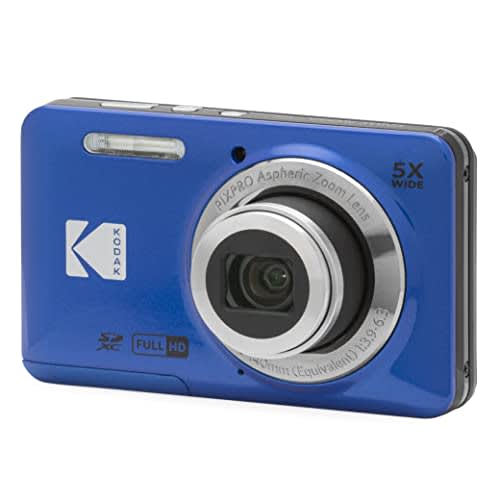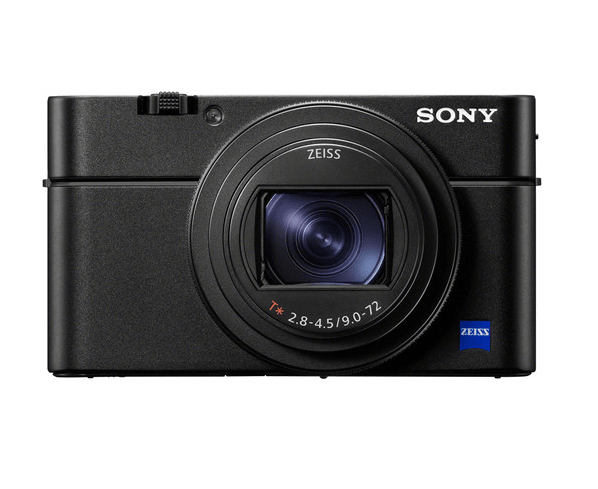Pull out any compact digital point-and-shoot camera at a party and everyone will want to take selfies. Pull out your smartphone, and people think you are tuning them out (even if you wanted to take a photo).
Pocketable point-and-shoot cameras are having a serious moment. New and old models are selling out, with most camera manufacturers struggling to keep up with demand. The Fujifilm X100VI, a very popular camera on social media, took me five months to receive after placing my pre-order.
As NBC Select’s tech reporter (and a photography enthusiast), I test cameras year-round. Below are some of the best point-and-shoot cameras, plus expert advice about what makes these cameras worthwhile.
Selected.
Show 1 More
Show Less
What is a point-and-shoot camera?
A point-and-shoot digital camera is typically small and compact, with a built-in lens and features like automatic photo and video modes, according to our experts. This is different from DSLR and mirrorless cameras, which can range in size and weight and have larger, removable lenses.
I focus on small and compact point-and-shoot cameras in this guide, but there are other kinds on the market too, including “super zoom” models with longer, bulkier lenses.
How I picked the best point-and-shoot cameras
To pick the best point-and-shoot cameras on the market, I try models from brands like Canon, Sony, Fujifilm, Kodak and Panasonic year-round. To learn more about cameras and current trends, I spoke with Mark Steinberg, the senior technologist at B&H Photo & Video, one of the biggest camera stores in the U.S. Putting that all together, I chose cameras based on the following criteria:
- Portability: A point and shoot camera is at its best when it fits easily into your pocket or bag. Nearly all of our top picks fit into most jacket pockets and weigh less than a pound.
- Control: A good point-and-shoot camera lets you do just that: point and shoot. I paid close attention to how each camera felt to control, especially its screen interface, buttons and dials.
- Zoom: Most point-and-shoot cameras have optical zoom lenses that can punch in to far distances without the digital compression of a smartphone or bulk of a traditional camera. I took photos of subjects close up and far away, and noted ease of use and image quality.
Want more from NBC Select? Sign up for our newsletter, The Selection, and shop smarter.
The best point-and-shoot cameras in 2025
My top picks come from a range of camera brands like Sony, Leica and Ricoh. I list key specifications I think you should know below each recommendation. If you find any of them confusing, you can learn more about the basics of photography, including terms like aperture, shutter speed and ISO, on sites like Adobe, MasterClass, Skillshare, and Expert Photography.
Nearly all of our top picks have been affected by tariffs in 2025, raising the prices to less appealing levels than in years past.
Best budget
If you are looking to spend under $200, but want something with more control than an instant camera, consider this budget Kodak camera. Former NBC Select associate reporter Bianca Alvarez took the Pixpro FZ55 abroad — it was so small and lightweight that she brought it everywhere without a second thought. It has a smaller sensor that lacks detail compared to our other picks, but it is one of the most affordable point-and-shoot cameras on the market. It also makes for a good gift to anyone looking to try out photography. Just note that it won’t perform very well in low-light environments.
The best, if it’s in-stock
This is one of the highest quality, most fully-featured compact cameras on the market. It is also one of the most coveted — I received mine five months after I placed my pre-order.
It has the largest and most detailed image sensor on our list (by far), and can capture incredibly sharp, detailed photos. This is made easy with the advanced auto-focus system — the camera uses AI-based subject detection to automatically focus on birds, animals, cars and even the individual eyes of a person’s face. The built-in image stabilization also means your shaky hands are less likely to cause blurry photos.
It has multiple dials and switches for precise control over your photography and videography. One of my favorite settings is the 20 Fujifilm film simulation modes — essentially “looks” with their own color, saturation, shadow detail and other settings to mimic the look of literal Fuji film.
The list of useful features goes on and on and on, but the camera does have a few limitations. The Fujifilm X100VI is the largest and heaviest camera on our list — I can fit it in large coat pockets, not a pants pocket. It also does not have a zoom lens. Both make it less flexible as a travel camera than our picks from Sony and Leica. You can learn more in my Fujifilm X100VI review.
Best zoom
Anyone looking for a compact camera that takes high-quality photos and doesn’t skimp on features should consider the Sony RX100 VII.
NBC News commerce photo editor Kara Birnbaum says this is the best point-and-shoot camera she has ever used. The images look crisp and clean, even in dark lighting, especially compared to similarly compact cameras from Panasonic and Kodak. Plus, the small size makes it easy for Birnbaum to bring it with her everywhere and snap photos when inspiration strikes — something that’s harder to do with her other cameras.
If this sounds like your dream camera but is out of your budget, consider the Sony ZV-1 as an alternative — it is more streamlined for taking videos, not photos, but has a similar design and controls.
Best compact
NBC Select commerce editor Jordan Bowman has taken some of his best photos with this camera — he brings it almost everywhere, after all, the best camera is the one you have with you.
It takes sharper, more detailed photos than nearly all of our other recommendations (except the Fujifilm X100VI). Much of that image quality is because of this camera’s large sensor, which captures more sharp detail and a wider range of light and shadows than our picks from Sony, Leica, Kodak and Panasonic.
That image quality comes at a cost — the camera has a fixed lens that cannot zoom in or out. But the fixed lens has a medium-wide field of view that’s great for portraits, street photography and snapshot style photos, says Bowman.
Best splurge
The Leica D-Lux 8 was my favorite point-and-shoot on this list when it launched at $1,595. It now costs $1,915, which makes it much more of a splurge-pick compared to our other top picks
I love the sleek design, precise manual controls and short but useful zoom range, but it’s the pictures I took that won me over. The larger than average image sensor delivers some remarkable shots that rival photos I’ve taken on much larger mirrorless cameras. It has a robust automatic mode, but I found myself tinkering with the many clicky dials to lock-in my exposure and create more thought-out images. The same cannot be said for most other point-and-shoot cameras I’ve tried.
It’s pricier and less pocketable than most of our other top picks. It also does not have a built-in flash, but it does come with a small flash unit you can slot into the top of the camera.
Staff-favorite
Over 10 NBC Select staffers tried this little vintage-style digital camera. It instantly won our hearts because of how easy it is to use and how fun it is to shoot with.
It is modeled after an old-school disposable point-and-shoot film camera: there are no settings to change, no screen to look at, it’s just a viewfinder, flash and a shutter button. The little LCD screen on the back also tells you how many photos you’ve taken — that’s it. The colorful, textured material on the front of the camera is attractive but also helps with grip, there is also a small thumb imprint on the back of the camera which helps you hold it as the camera is very rectangular.
The downside is unfortunately the photos themselves: the photos we took were largely hit or miss. Our favorites were either taken outdoors with an abundance of light or inside with the flash on. You can learn more in my Camp Snap camera review.
Best for video
While it looks like a regular point-and-shoot camera, the Canon Powershot V1 is a video camera at heart, with features largely focused on easily capturing video content. It has easy to understand touch screen controls (along with dials and buttons), snappy autofocus and an included microphone cover that helps muffle wind noise.
While it’s centered on video, it’s a decent photo camera too, especially for under $1,000. Its larger than average image sensor means more detailed shots than many competitors (including our Kodak and Panasonic picks). Plus, unlike many cameras on this list, it has been consistently in-stock online since its launch in April 2025
Best superzoom
If you want to photograph subjects at a distance — think wildlife or architectural details, but don’t want to lug around a big camera, this is the model to get. It has an incredible zoom range of 720 millimeters, over triple that of the Sony RX100 VII. Plus it has image stabilization built-in to help mitigate camera shake, especially when zoomed in on far-off subjects.
I’ve tested previous models in the Lumix ZS series, and found them to deliver a good mix of image quality, ease of use and portability. While image quality can’t compete with our picks from Sony and Leica, neither zoom nearly as far as the Lumix ZS99 does.
For underwater adventure
If you need a durable camera that you can use in basically any environment, Steinberg recommends the Olympus TG series. This TG-7 is the latest model and its designed for extreme conditions — you can use it underwater up to about 50 feet, according to the brand. Plus it’s shockproof up to seven feet and crushproof, able to resist up to 220 pounds of force. Upgrades from the previous TG-6 include a more color-accurate screen, a ribbed plastic texture around the grip, USB-C charging and more.
There is a tradeoff to its small size and durable build — it has a smaller, less detailed sensor compared to many of our top picks.
View this graphic on nbcnews.comHow to shop for a point-and-shoot camera
Cameras, even within a sub-category like point-and-shoot, can vary in shape, size and function. The Om System Tough TG-7 and Panasonic Lumix ZS99 may have a similar price tag, but they look, feel and function very differently. Below are a few things our experts recommend keeping in mind as you shop for your next camera.
What are you looking to photograph?
A camera that’s great for taking family portraits may not also be great at photographing far-off wildlife. Before you purchase any camera, it’s important to understand what you are looking to photograph or film.
If you want to shoot photos of wildlife, look for a camera with a long zoom range — professional wildlife lenses typically have a minimum zoom length of at least 200mm, according to B&H Photo & Video. If you plan on mostly shooting video, consider choosing a camera with a flip-up screen that makes it easier to film yourself, and one that can shoot video in a 4K resolution. If you love the detail of a sunset or texture of flower petals, look for a camera with a larger image sensor, it’s going to capture those details with more clarity, in my experience.
How does it feel to use the camera?
I’ve tested enough cameras to know that sometimes it’s all about feel. Some cameras feel great in my hands, some don’t. Before purchasing your next camera, consider shopping in-person so you can physically hold and test your options, says Steinberg.
Frequently asked questions
Are point-and-shoot cameras better than phone cameras?
There are pros and cons to point-and-shoot cameras and phone cameras.
New, high-end phones may take “better” photos and videos than some point-and-shoot cameras, according to Steinberg.
However, if you are looking to use your photos outside of social media, look for a camera that can shoot raw image files, says Birnbaum. Raw files are the purest form of a digital image, and are much more detailed and well-suited to photo editing and printing. Most phone cameras cannot shoot raw image files, while most dedicated cameras can.
Point-and-shoot cameras are typically more ergonomic than phone cameras — they are easier to hold and easier to control, says Steinberg. That’s likely because phones were never designed with photography as their sole purpose.
Outside of models like the Om System Tough TG-7, most cameras aren’t totally weatherproof. By contrast, nearly all smartphones are, with high IP ratings to match.
Ultimately, our experts agree that the best camera is the one you have with you. “If you don’t have your camera ready, you miss your shot,” says Steinberg.
Meet our experts
At NBC Select, we work with experts who have specialized knowledge and authority based on relevant training and/or experience. We also take steps to ensure all expert advice and recommendations are made independently and without undisclosed financial conflicts of interest.
- Mark Steinberg is the senior technologist at B&H Photo & Video. He has decades of experience in camera and electronic sales. (B&H Photo sells hundreds of cameras, and Steinberg does not have affiliations with any individual camera brand).
- Kara Birnbaum is a commerce photo editor at NBC News. She photographs and produces commercial stock imagery for NBC Select, CNBC Select, Shop Today and MSNBC.
Why trust NBC Select?
I am a reporter at NBC Select who covers technology and fitness including recent stories on smartwatches, running shoes, workout earbuds and more. For this piece, I tried top-rated point-and-shoot cameras along with other staffers for a month. I also spoke with photography and retail experts to better understand point-and-shoot cameras and their place in the current market.
More tech essentials
- The 6 best Amazon Kindle alternatives, tested by our editors
- Is your device waterproof? Here’s what IP ratings really mean
- I’ve tested dozens of fitness trackers — here are the best ones for beginners, runners and more
- Where to listen to audiobooks: Our favorite apps and subscriptions
- Apple AirTag Review: Are Apple AirTags actually worth it? We say yes.
Catch up on NBC Select’s in-depth coverage of tech and tools, wellness and more, and follow us on Facebook, Instagram, Twitter and TikTok to stay up to date.




